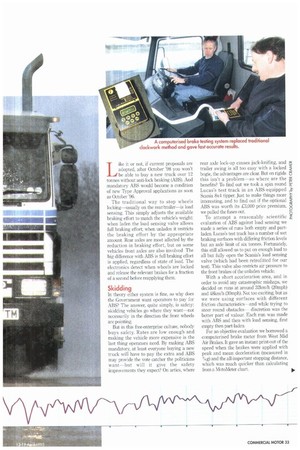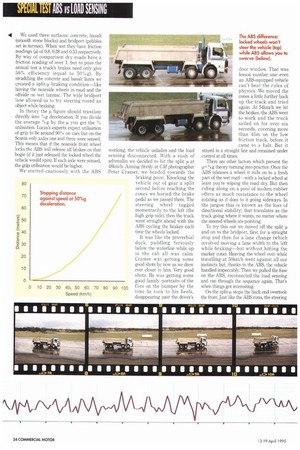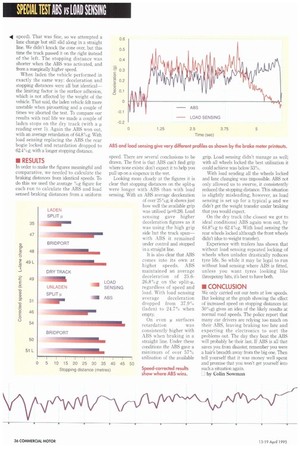YIHAT YOU?
Page 34

Page 35

Page 36

Page 37

Page 38

If you've noticed an error in this article please click here to report it so we can fix it.
Artic operators have been forced to run with ABS for some time. Now the legislators have rigid vehicles in their sights.
Does ABS offer better braking on a rigid than load sensing? We tried an eight-legger with both systems on a wide range of road surfaces.
Like it or not, if current proposals are adopted, after October '98 you won't be able to buy a new truck over 12 tonnes without anti-lock braking (ABS). And mandatory ABS would become a condition of new Type Approval applications as soon as October '96.
The traditional way to stop wheels locking—usually on the rear/trailer—is load sensing. This simply adjusts the available braking effort to match the vehicle's weight: when laden the load sensing valve allows full braking effort; when unladen it restricts the braking effort by the appropriate amount. Rear axles are most affected by the reduction in braking effort, but on some vehicles front axles are also involved The big difference with ABS is full braking effort is applied, regardless of state of load. The electronics detect when wheels are locked and release the relevant brakes for a fraction of a second before reapplying them.
Skidding
In theory either system is fine, so why does the Government want operators to pay for ABS? The answer, quite simply, is safety: skidding vehicles go where they want—not necessarily in the direction the front wheels are pointing.
But in this free-enterprise culture, nobody buys safety. Rates are low enough and making the vehicle more expensive is the last thing operators need. By making ABS mandatory, at least everyone buying a new truck will have to pay the extra and ABS may provide the vote catcher the politicians want—but will it give the safety improvements they expect? On artics, where rear axle lock-up causes jack-knifing, and trailer swing is all too easy with a locked bogie, the advantages are clear. But on rigids this isn't a problem—so where are the benefits? To find out we took a spin round Lucas's test track in an ABS-equipped Scania 8x4 tipper. Just to make things more interesting, and to find out if the optional ABS was worth its £3,000 price premium, we pulled the fuses out.
To attempt a reasonably scientific evaluation of ABS against load sensing we made a series of runs both empty and partladen. Lucas's test track has a number of wet braking surfaces with differing friction levels but an axle limit of six tonnes. Fortunately, this still allowed us to put on enough load to all but fully open the Scania's load sensing valve (which had been retrofitted for our test). This valve also restricts air pressure to the front brakes of the unladen vehicle.
With a short acceleration area, and in order to avoid any catastrophic mishaps, we decided on runs at around 32krrilh (20mph) and 48km/h (30mph). Not too exciting, but as we were using surfaces with different friction characteristics and while trying to steer round obstacles— discretion was the better part of valour. Each run was made with ABS and then with load sensing, first empty then part-laden.
For an objective evaluation we borrowed a computerised brake meter from West Mid Air Brakes. It gave an instant print-out of the speed when the brakes were applied with peak and mean deceleration (measured in %g) and the all-important stopping distance, which was much quicker than calculating from a MotoMeter chart.
.4 We used three surfaces: concrete, basalt
(smooth stone blocks) and bridport (pebbles set in tarmac). When wet they have friction readings (u) of 0.8, 0.28 and 0.53 respectively, By way of comparison dry roads have a friction reading of over 1, but to pass the annual test a truck's brakes need only give 50% efficiency (equal to 50%g). By straddling the concrete and basalt lanes we created a split-g braking condition—like having the nearside wheels in mud and the offside on wet tarmac. The wide bridport lane allowed us to try steering round an object while braking.
In theory the u figure should translate directly into %g deceleration. If you divide the average %g by the u you get the % utilisation. Lucas's experts expect utilisation of grip to be around 90% on cars but on the Scania only axles one and three were sensed. This means that if the nearside front wheel locks the ABS will release all brakes on that bogie (if it just released the locked wheel the vehicle would spin). If each axle were sensed, the grip utilisation would be higher.
We started cautiously with the ABS
working, the vehicle unladen and the load sensing disconnected. With a rush of adrenalin we decided to hit the split j at 48km/h. Aiming firmly at CM photographer Peter Cramer, we headed towards the
braking point. Knocking the vehicle out of gear a split second before reaching the cones we buried the brake pedal as we passed them. The steering wheel tugged momentarily to the left (the high grip side), then the truck went straight ahead with the ABS cycling the brakes each time the wheels locked.
It was like the proverbial duck, paddling furiously below the waterline while up in the cab all was calm: Cramer was getting some good shots by now as we drew ever closer to him. Very good shots. He was getting some good family portraits of the 70 80 90 100 flies on the bumper by the time he took to his heels, disappearing past the driver's door window. That was lesson number one: even an ABS-equipped vehicle can't beat the rules of physics. We moved the cones a little further back up the track and tried again. At 541cm/h we hit the brakes, the ABS went to work and the truck sailed on for over six seconds, covering more than 45m on the low friction track, before it came to a halt. But it stayed in a straight line and remained under control at all times.
There are other factors which prevent the
%g theory turning into practice. Once the ABS releases a wheel it rolls on to a fresh part of the wet road—with a locked wheel at least you're wiping the road dry. But then riding along on a pool of molten rubber offers as much resistance to the wheel rotating as it does to it going sideways. In the jargon this is known as the loss of directional stability; that translates as the truck going where it wants, no matter where the steered wheels are pointing.
To try this out we moved off the split ).t and on to the bridport, first for a straight stop and then for a lane change (which involved moving a lane width to the left while braking—but without hitting the marker cone). Heaving the wheel over while travelling at 50km/h went against all our instincts but, thanks to the ABS, the vehicle handled impeccably. Then we pulled the fuse on the ABS, reconnected the load sensing and ran through the sequence again. That's when things got interesting On the split* stops the back end overtook the front. Just like the ABS runs, the steering wheel gave an initial tug to the high-p. side, but with load sensing it then went very light. Despite winding on right-hand lock the tail kicked out to the offside taking the rear bogie fully onto the more slippery basalt. This directed the front end on to the higher p. concrete, resulting in the back of the truck overtaking the front.
If you've ever had an eight-legger sideways you know it's a memorable experience. It all happens in slow motion but it seemed to go on for an eternity. In fact it only lasted six seconds, stopping in 45.7m which was fractionally longer than when the ABS was switched on. We were perfectly safe on a test track with nothing to hit except the odd cone (Cramer is a quick learner and was now safely ensconced in the observation platform behind a long lens). However, the consequences of duplicating this experience on the road are too grimn to contemplate.
On the bridport the load sensing allowed all the wheels to lock up and we slid along in a straight line, stopping slightly quicker than with ABS (but from a slightly lower speed). That was fine, so we attempted a lane change but still slid along in a straight line. We didn't knock the cone over, but this time the truck passed it on the right instead of the left. The stopping distance was shorter when the ABS was activated, and from a marginally higher speed.
When laden the vehicle performed in exactly the same way: deceleration and stopping distances were all but identical— the limiting factor is the surface adhesion, which is not affected by the weight of the vehicle. That said, the laden vehicle felt more unstable when pirouetting and a couple of times we aborted the test. To compare our results with real life we made a couple of laden stops on the dry track (with a g reading over 1). Again the ABS won out, with an average retardation of 64.8°0g. With load sensing replacing the ABS the rear bogie locked and retardation dropped to 62.4%g, with a longer stopping distance.
• RESULTS In order to make the figures meaningful and comparative, we needed 'to calculate the braking distances from identical speeds. To do this we used the average %g figure for each run to calculate the ABS and load sensed braking distances from a uniform
speed. There are several conclusions to be drawn. The first is that ABS can't find grip where none exists: don't expect it to help you pull up on a sixpence in the wet.
Looking more closely at the figures it is clear that stopping distances on the split-p. were longer with ABS than with load sensing. With an ABS average deceleration of over 25°0g, it shows just how well the available grip was utilised (u=0.28). Load sensing gave higher deceleration figures as it was using the high grip side but the truck spun— with ABS it remained under control and stopped in a straight line.
It is also clear that ABS comes into its own at higher speeds. ABS maintained an average deceleration of 25.626.8%g on the split-p., regardless of speed and load. With load sensing average deceleration dropped from 37.9% (laden) to 24.7°c when empty.
On even 1.1 surfaces
retardation was consistently higher with ABS when braking in a straight line. Under these conditions the ABS gave a minimum of over 57% utilisation of the available
grip. Load sensing didn't manage as well: with all wheels locked the best utilisation it could achieve was below 53°0.
With load sending all the wheels locked and lane changing was impossible. ABS not only allowed us to swerve, it consistently reduced the stopping distance. This situation is slightly misleading, however, as load sensing is set up for a typical 1.1 and we didn't get the weight transfer under braking that you would expect.
On the dry track (the closest we got to ideal conditions) ABS again won out, by 64.8%g to 62.4%g. With load sensing the rear wheels locked although the front wheels didn't (due to weight transfer).
Experience with trailers has shown that without load sensing repeated locking of wheels when unladen drastically reduces tyre life. So while it may be legal to run without load sensing where ABS is fitted, unless you want tyres looking like threepenny bits, is best to have both.
• CONCLUSION We only carried out our tests at low speeds. But looking at the graph showing the effect of increased speed on stopping distances (at 50%g) gives an idea of the likely results at normal road speeds. The police report that many car drivers are relying too much on their ABS, leaving braking too late and expecting the electronics to sort the problems out. The day they beat the ABS will probably be their last. If ABS is all that saves you from disaster, remember you were a hair's breadth away from the big one. Then tell yourself that it was money well spent and promise that you won't get yourself into such a situation again.
by Colin Sowman
































































































